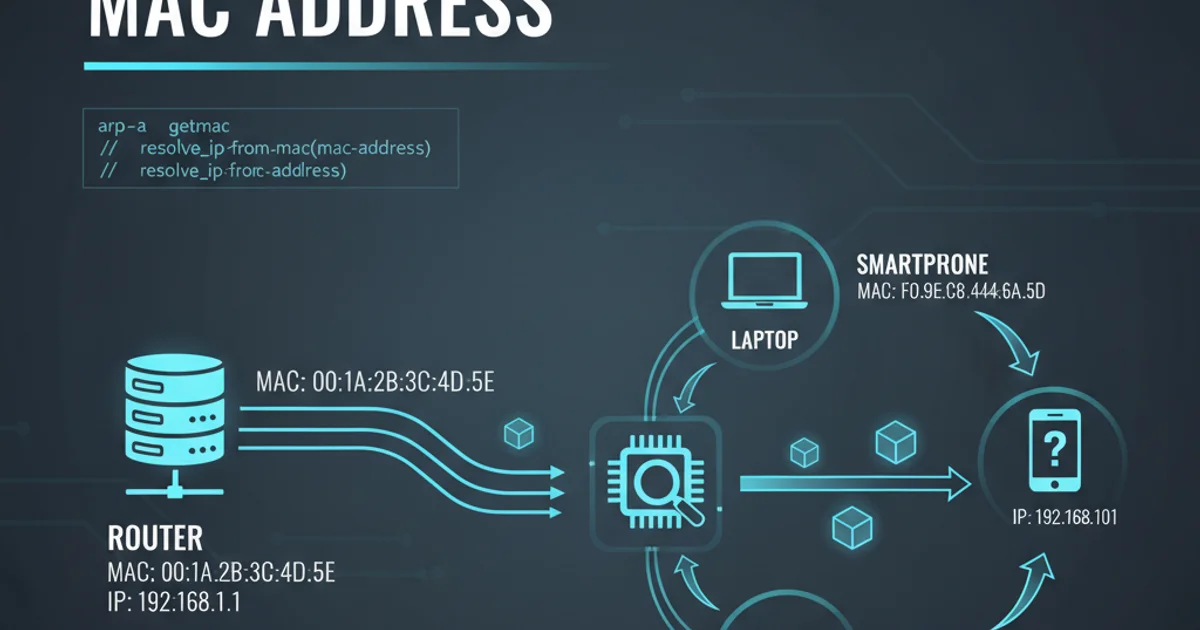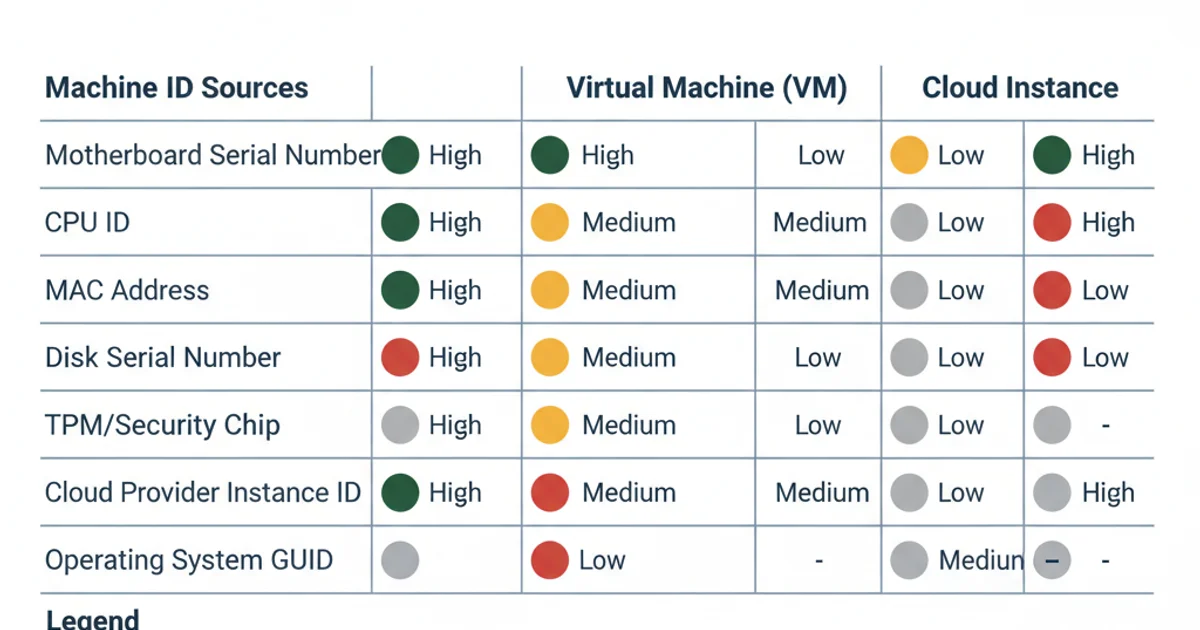get unique machine id
Categories:
Generating a Unique Machine ID in C#

Learn various methods to obtain a unique identifier for a machine using C#, exploring hardware-based and software-based approaches.
Identifying a unique machine can be crucial for licensing, security, or tracking purposes in software applications. While there's no single, universally 'perfect' unique identifier, C# offers several ways to gather information that, when combined, can create a reasonably unique machine fingerprint. This article explores common techniques, their advantages, and their limitations.
Understanding 'Unique' Machine IDs
The concept of a 'unique machine ID' is often a compromise. True uniqueness is hard to guarantee across all scenarios, especially with virtual machines, hardware changes, or cloud environments. The goal is typically to find an identifier that is stable enough for the application's needs and sufficiently distinct from other machines. Common sources include CPU ID, BIOS serial number, motherboard serial number, and MAC addresses.
flowchart TD
A[Start] --> B{Identify Machine ID Needs?}
B -->|Licensing/Security| C[Hardware-based IDs]
B -->|Tracking/Analytics| D[Combined/Software-based IDs]
C --> E{"WMI (Win32_Processor, Win32_BIOS, Win32_BaseBoard)"}
C --> F{"NetworkInterface.GetAllNetworkInterfaces()"}
D --> G{"Registry/File-based GUID"}
E --> H[Generate Composite ID]
F --> H
G --> H
H --> I[End]Decision flow for selecting machine ID components
Hardware-Based Identifiers
Hardware-based identifiers are generally considered more stable than software-based ones, as they are tied directly to the physical components of the machine. However, they can change if hardware is upgraded or replaced. The Windows Management Instrumentation (WMI) is a powerful tool in C# for querying system hardware information.
using System;
using System.Management;
using System.Net.NetworkInformation;
using System.Linq;
public class MachineIdGenerator
{
public static string GetCpuId()
{
using (ManagementObjectSearcher searcher = new ManagementObjectSearcher("SELECT ProcessorId FROM Win32_Processor"))
{
ManagementObjectCollection collection = searcher.Get();
foreach (ManagementObject mo in collection)
{
return mo["ProcessorId"].ToString();
}
}
return string.Empty;
}
public static string GetBiosSerialNumber()
{
using (ManagementObjectSearcher searcher = new ManagementObjectSearcher("SELECT SerialNumber FROM Win32_BIOS"))
{
ManagementObjectCollection collection = searcher.Get();
foreach (ManagementObject mo in collection)
{
return mo["SerialNumber"].ToString();
}
}
return string.Empty;
}
public static string GetMotherboardSerialNumber()
{
using (ManagementObjectSearcher searcher = new ManagementObjectSearcher("SELECT SerialNumber FROM Win32_BaseBoard"))
{
ManagementObjectCollection collection = searcher.Get();
foreach (ManagementObject mo in collection)
{
return mo["SerialNumber"].ToString();
}
}
return string.Empty;
}
public static string GetMacAddress()
{
return NetworkInterface.GetAllNetworkInterfaces()
.Where(nic => nic.OperationalStatus == OperationalStatus.Up && nic.NetworkInterfaceType != NetworkInterfaceType.Loopback)
.Select(nic => nic.GetPhysicalAddress().ToString())
.FirstOrDefault();
}
public static string GenerateUniqueMachineId()
{
string cpuId = GetCpuId();
string biosSerial = GetBiosSerialNumber();
string motherboardSerial = GetMotherboardSerialNumber();
string macAddress = GetMacAddress();
// Combine and hash for a more robust ID
string combinedId = $"{cpuId}-{biosSerial}-{motherboardSerial}-{macAddress}";
using (System.Security.Cryptography.MD5 md5 = System.Security.Cryptography.MD5.Create())
{
byte[] inputBytes = System.Text.Encoding.ASCII.GetBytes(combinedId);
byte[] hashBytes = md5.ComputeHash(inputBytes);
return BitConverter.ToString(hashBytes).Replace("-", "");
}
}
public static void Main(string[] args)
{
Console.WriteLine($"CPU ID: {GetCpuId()}");
Console.WriteLine($"BIOS Serial: {GetBiosSerialNumber()}");
Console.WriteLine($"Motherboard Serial: {GetMotherboardSerialNumber()}");
Console.WriteLine($"MAC Address: {GetMacAddress()}");
Console.WriteLine($"Generated Machine ID: {GenerateUniqueMachineId()}");
}
}
Software-Based and Composite Identifiers
For scenarios where hardware IDs are too volatile or unavailable, or when a more application-specific identifier is needed, a software-based approach can be used. This often involves generating a GUID and persisting it, or combining multiple hardware identifiers and hashing them to create a composite ID.
using System;
using Microsoft.Win32;
using System.IO;
public class SoftwareIdGenerator
{
private const string RegistryKeyPath = "SOFTWARE\\YourCompany\\YourApp";
private const string IdValueName = "MachineGuid";
private const string FilePath = "machineid.dat";
public static string GetOrCreateSoftwareId()
{
string id = GetIdFromRegistry();
if (string.IsNullOrEmpty(id))
{
id = GetIdFromFile();
}
if (string.IsNullOrEmpty(id))
{
id = Guid.NewGuid().ToString();
SaveIdToRegistry(id);
SaveIdToFile(id);
}
return id;
}
private static string GetIdFromRegistry()
{
using (RegistryKey key = Registry.LocalMachine.OpenSubKey(RegistryKeyPath))
{
return key?.GetValue(IdValueName)?.ToString();
}
}
private static void SaveIdToRegistry(string id)
{
using (RegistryKey key = Registry.LocalMachine.CreateSubKey(RegistryKeyPath))
{
key.SetValue(IdValueName, id);
}
}
private static string GetIdFromFile()
{
if (File.Exists(FilePath))
{
return File.ReadAllText(FilePath);
}
return string.Empty;
}
private static void SaveIdToFile(string id)
{
File.WriteAllText(FilePath, id);
}
public static void Main(string[] args)
{
Console.WriteLine($"Software-based Machine ID: {GetOrCreateSoftwareId()}");
}
}
Considerations for Different Environments
The choice of identifier depends heavily on the deployment environment:
- Physical Machines: Hardware IDs (CPU, BIOS, Motherboard, MAC) are generally reliable.
- Virtual Machines (VMs): Many hardware IDs can be virtualized or identical across cloned VMs. A generated GUID stored in a persistent location (e.g., registry, configuration file) or a combination of virtualized hardware IDs might be more suitable.
- Cloud Instances: Cloud providers often assign unique instance IDs. For custom applications, a generated GUID stored in persistent storage (like a database or cloud-specific metadata service) is usually the best approach.
- Containers (Docker): Containers are ephemeral. Relying on host machine IDs is generally not feasible. A unique ID should be generated and passed into the container, or the container should generate and store its own ID in a persistent volume if needed across restarts.

Reliability of Machine ID Sources by Environment